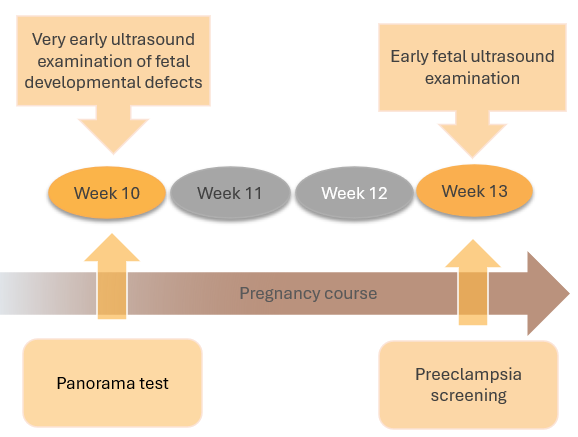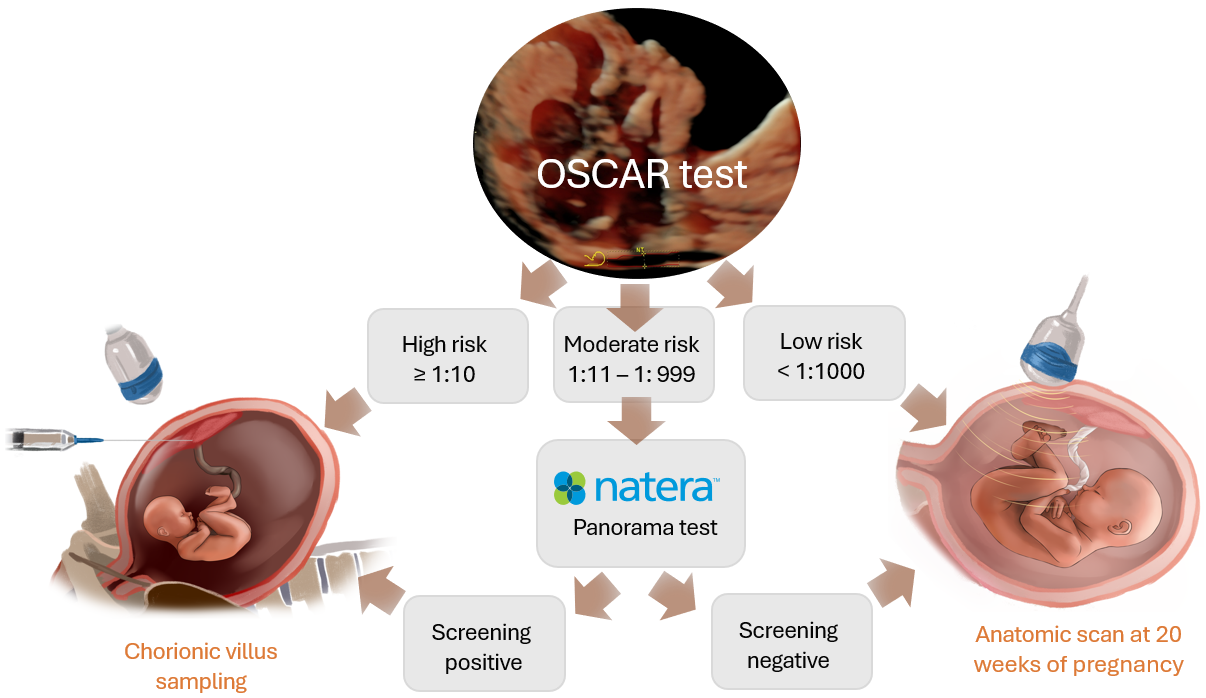Panorama test + OSCAR test

The Fetal Ultrasound Screening Centre offers a combined first-trimester screening test that uses the strengths of both the OSCAR and Panorama tests. This results in a new screening test that is significantly more accurate and comprehensive than the OSCAR and Panorama tests alone.
-
Strengths of the OSCAR test
- During the OSCAR test, it is possible to recognize fetuses with a very high risk of chromosomal diseases during the ultrasound examination. Instead of the Panorama test, it would be justified to do an immediate chorionic biopsy together with the FISH (fluorescence in situ hybridization) analysis on the interphase chromosomes, which is used to detect chromosomal diseases, the answer to which the woman usually receives in 24-48 hours within the period after performing the chorionic biopsy.
- Ultrasound can detect chromosomal and genetic diseases in fetuses with an enlarged nuchal translucency (NT), which cannot be detected using the Panorama test. Suppose the NT of the fetus exceeds 3.0 mm. In that case, it is recommended that a submicroscopic chromosomal analysis of the chorion villus sampling be performed instead of the Panorama test and sequencing of the gene panel using the NGS method.
- During the OSCAR test, it is possible to detect structural pathologies of the fetus, which may be a manifestation of rare genetic diseases, including those not detected by the Panorama test. In the case of structural fetal pathology detected by ultrasound, the usual assessment of fetal karyotype after chorionic biopsy is not indicated, but the use of an extended panel of genetic diseases is required. Without the OSCAR test, these serious genetic diseases that threaten the life and health of the fetus would have remained unnoticed.
- Ultrasound can detect fetal development defects not associated with chromosomal pathology or a currently known gene defect. At the same time, these are developmental defects, which are often higher in frequency than Down syndrome and may result in a significant disability for the child in the future. Most often, these are severe congenital heart defects, which in some cases can already be detected on an ultrasound scan of the size of a given pregnancy.
- The OSCAR test is a vital tool for healthcare professionals, particularly when dealing with overweight women. It allows for a reliable assessment of the organ structures of the fetus, especially through the vagina, at a specific stage of pregnancy. This test is crucial in detecting and understanding fetal developmental defects, which can be challenging to identify through ultrasound examination in overweight women due to thick abdominal covers. By understanding the role of the OSCAR test, healthcare professionals can feel more informed and prepared to provide the best care for their patients.
- The OSCAR test is indicated for women who have become pregnant through artificial insemination, as their children have an increased risk of congenital developmental defects.
- During the OSCAR test, it is possible to assess the severe risks of potentially life-threatening complications for both mother and child, preeclampsia, fetal growth retardation in utero, and premature birth.
The Panorama test cannot be used as part of a combined screening test in the following cases:
- in the case of a twin pregnancy, when one of the fetuses has died;
- in the case of multiple pregnancies, when the mother has become pregnant using the donor egg;
- if a pregnant woman has had a bone marrow transplant before conception;
- for triplets;
- if the Panorama test fails due to the low amount of extracellular DNA.
In the latter case, the OSCAR test is the only screening for women to assess the chromosomal risk of foetuses/fetuses.
-
Strengths of the Panorama test
- The Panorama test is currently the most accurate screening test for chromosomal diseases and one of the most accurate prenatal screening tests in the world. It recognises 0.1% of fetuses with a false positive rate of 99.9% with Down, 96.4% with Edwards, and 99% with Patau syndrome. The Panorama test can be used for both identical twins and fraternal twins.
- The Panorama test makes it possible to detect more different chromosomal pathologies. In addition to the pathologies above, the Panorama test can detect Turner (monosomy X), Klinefelter (XXY), Jacob (XYY), Triple X (XXX) and triploidy syndrome (69 XXX/69XXY) and identify the sex of the fetus without fail.
- If desired, it is possible to order a microdeletion panel together with the Panorama test, which can be used to detect the five most common gene defects causing mental retardation: DiGeorge syndrome, Angelman syndrome, Cri-du-chat syndrome, 1p36 deletion syndrome, Prader-Willi syndrome.
- The Panorama test is the preferred screening test for chromosomal disorders in twins, as false-positive results are more common in this case with the OSCAR test than in singleton pregnancies. The Panorama test allows for distinguishing between identical twins or fraternal twins.
- The Panorama test is the preferred screening test for chromosomal diseases in overweight women because, in this case, false positive and false negative results are more common in the OSCAR test than in normal-weight women.
- The Panorama test is the preferred screening test for chromosomal disorders in women who conceived through artificial insemination, as false-positive results with the OSCAR test, in this case, are more common than in women who conceived spontaneously.
- The Panorama test may be the only screening test offered to a woman if fetal structures cannot be assessed due to the thickness of her abdominal lining.
- The Panorama test does not make a mistake in assessing the gender of the fetus.
- The Panorama test is currently the most accurate screening test for chromosomal diseases and one of the most accurate prenatal screening tests in the world. It recognises 0.1% of fetuses with a false positive rate of 99.9% with Down, 96.4% with Edwards, and 99% with Patau syndrome. The Panorama test can be used for both identical twins and fraternal twins.
The Panorama test can be performed both before and after the OSCAR test.
Performing the Panorama test before the OSCAR test
Since during the Panorama test, it is not possible to assess the anatomical structures of the fetus or the risk of neural tube pathology, congenital heart disease, pregnant preeclampsia and premature birth; it is possible to perform the Panorama test as early as the 10th week of pregnancy and plan the OSCAR test for the 13th week of pregnancy. When a woman arrives for the OSCAR test, it is already known whether the child is a boy or a girl, and the child has not been searched for a chromosomal disease. In this case, the ultrasound examination no longer pays attention to the chromosomal markers; instead, the child's organ systems, brain, and heart structures are examined in depth.
Before performing the Panorama test in the 10th week of pregnancy, a very early ultrasound examination of fetal developmental defects is performed, where it is made sure that the fetus is alive, the size of the pregnancy, and the number of fetuses are specified. In addition, it is confirmed that the fetus has no evaluable severe developmental disorders for the given gestational size, for which screening tests are not indicated.
Performing the Panorama test after the OSCAR test
To increase the detection rate of fetuses with Down syndrome and reduce the number of women referred for invasive testing, we offer the Panorama test to women who remain in the medium-risk group after the OSCAR test (1:11 - 1:999). Using this combined screening method, we detect 98% of fetuses with Down syndrome and refer only one in every hundred women for invasive examination. Performing the Panorama test in a group of women with a shallow risk of Down syndrome (risk less than 1:1000) is not reasonable, as the probability that women in this subgroup will have a fetus with Down syndrome is vanishingly tiny.
At the same time, if the woman belongs to the medium risk group but the fetus had an occipital fold greater than 3.0 mm, we recommend a chorionic villus sampling for these women, as their children may have a chromosomal or gene defect that cannot be detected with the Panorama test.



